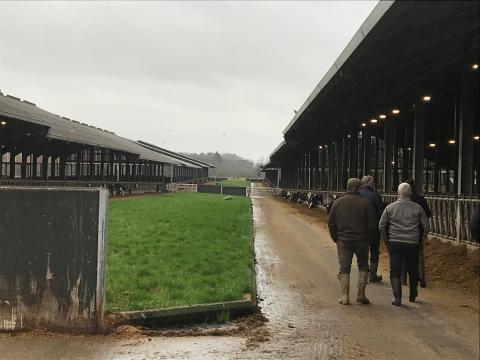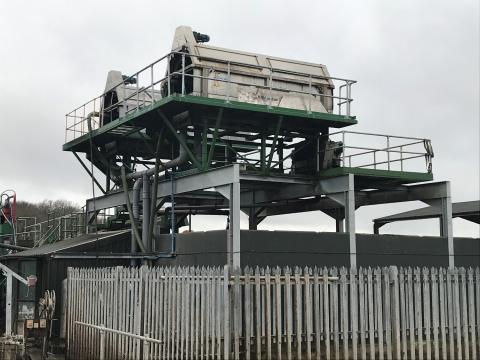Farming Connect Study Visit - Pentagon Dairy Discussion Group
Pentagon Dairy Discussion Group
Cheshire Study Tour
23 - 25 January 2020
1 Background
The Pentagon Dairy Discussion Group consists of members of a benchmarking group and other large herd dairy farmers from South Wales. The members meet on a regular basis to review and discuss their farming systems and financial performance. It was felt that in order to progress they needed to challenge themselves. Therefore, they sought farmers of a similar type and size that exhibit industry best practice outside of the immediate group to learn from them.
The aims and objectives of the visit were to compare and develop relationships with farmers outside of their own group and challenge their own farming practices. The main emphasis was to meet with farmers producing high yields of quality milk with low purchased feed costs, utilising high quality, home-produced forages.
2 Itinerary
2.1 Day 1
We left Carmarthen on Thursday morning at 8:00 and headed towards Pryddbwll Farm near Llangedwyn in Powys.
We arrived at Pryddbwll Farm and were greeted by the owner, Martin Evans. We enjoyed a cup of tea and a biscuit in a redundant portal-framed building that had been converted into a farm office by Martin, whilst we discussed the structure of his business.
Martin left school at 16 years of age and has developed a dairy unit and diversified into poultry and tourism having developing farmhouses and redundant farm buildings into holiday lets. Martin runs an agricultural contracting business as well as an agricultural building business.
We started with a tour of the poultry unit. Martin showed us the woodchip boiler used to heat the poultry unit and discussed the economics of rearing poults. Next, we toured the yard used to store equipment for the agricultural contracting business. We were surprised that the contracting rates were similar to Pembrokeshire and Carmarthenshire. The site was also used for rearing youngstock, with impressive buildings. We then visited the farmhouse that Martin had converted into a holiday let.
Martin gave us a tour of the dairy unit, and we discussed various protocols and performance of the unit, which has a high average yield with low purchased feed costs. Martin was constructing a new building to allow for further expansion. The building frame was second hand and had been adapted as a livestock building.
We left Martin’s farm at 15:00 and headed to John Allwood’s farm, Huntingdon Hall, which is located just outside Chester. John gave a tour of the unit which is a large high-yielding herd with low purchased feed costs. The facilities were very impressive, facilitating a high level of herd management. We viewed the silage clamps and discussed the high-quality forages including lucerne produced on the farm. We also discussed the challenges of farming near a built-up area and the logistics of moving forage and manures through the centre of Chester.
We left the farm at 17:30 and headed towards the hotel, that was outside of Chester, before attending a presentation by Genus to discuss the merits and benefits of genomic testing.
Lessons learned:
- The challenge of managing a diversified business and staff management.
- The importance of high-quality forages to drive down production costs whilst achieving high yields.
- The potential of genomic testing and future animal performance.
2.2 Day 2
After a good breakfast, we travelled to Grosvenor Farms which is the Duke of Westminster’s flagship dairy unit.
The farm director gave a tour of the dairy and dry cow unit. The unit has 2,100 dairy cows and followers and the herd’s average yield is 12,300 litres. By utilising high quality forages, they achieve high yields from lower levels of purchased concentrates.
We viewed the milk parlour, discussed parlour routine, and viewed the impressive arrangement of farm buildings.
The unit benefits from deep sand cubicles, which has necessitated the need for sand separation. The members of the group were very keen to view the separator, which had a large particle size to aid separation, and as a result, recycles up to 70% of the sand.
The separation system is shown below.
The visit highlighted the importance of high-quality forages to reduce purchased feed costs.
We discussed the benefits of genomic testing and the staff management policy at Grosvenor.
We left Grosvenor Farms and headed towards our afternoon visit at Bubney Farms. We stopped for lunch on the way before being greeted by the owner, Andrew Evans at Bubney Farms.
Andrew led the tour of the dairy unit, which has a 12,500-litre herd average, with low purchased feed costs. We reviewed the feed ration and composition of the diet, as well as the importance of high-quality forages in reducing purchased feed costs. We agreed that the importance of having good quality land available around the farm and how this, coupled with his own equipment, had allowed him to produce high quality forages. Having been let down by his contractor, Martin had used the contracting fees to purchase his own equipment and therefore becoming self-sufficient.
Lessons learned:
- The importance of good facilities and staff management.
- The importance and availability of good land to produce high quality forages, in order to maintain high yield whilst driving purchased feed costs down.
- Genomic testing and the future role that it will play in improving profitability.
2.3 Day 3
Leaving Chester, we headed to our final visit with Richard Bowdler, who runs two flying herds of cows, totalling 1,100 heads on a very simplistic management system. The high yielding herds had low purchased feed costs.
Richard was farming on two sites, one of which was rented. It was interesting to see how the farming business had been expanded, utilising rented units and land on Farm Business Tenancy (FBT) agreements. Richard managed the staff on both units, and the business had very little of its own equipment as they used contractors.
The conversation continued over lunch at the local pub before heading back to Carmarthenshire.
Lessons learned:
- Keep things simple.
- Opportunities to rent farms under FBT to expand without incurring significant capital expenditure.
- Sourcing sufficient cattle to maintain a flying herd.
- High yield with low purchased feed costs.
3 Next Steps
During the three days, we gained a lot of useful information. We were able to compare our own businesses to other business of similar size, and how they have developed and adapted their businesses.
Members of the group have been invigorated by the trip, which has motivated them to assess their own farming practice and ways in which they can become more efficient. The trip highlighted the need to produce high quality forages and to reduce purchased feed costs.
Actions going forward
- To review current feed rations and to reduce purchased concentrates whilst increasing forage intakes.
- To produce higher quality forages reducing purchased feed costs.
- To consider alternative forages and moist feeds.
- A further study tour is planned to visit farms producing high quality forages including lucerne production to improve technical performance.
- To seek further technical advice.
- To develop a longer lasting relationship with the host farms, whilst continuing to share best practice and consider forming a wider benchmarking group to promote knowledge transfer.


